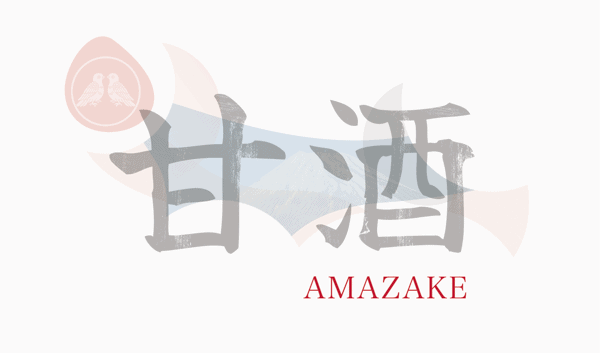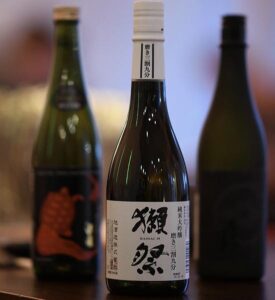Amazake - All about the non-alcoholic sake

Amazake is a traditional drink popular in Japan, often drunk seasonally. Amasake is of ingredients, history and production with the Japanese sake (Nihonshu) related, but alcohol-free and much easier to produce. Due to its limited shelf life, it is little known outside Japan, but in recent years it is also receiving increasing attention in Germany due to its positive health effects. Here you can learn everything about the sweet, alcohol-free sake.
What is Amazake?
The term "Amazake" is a traditional Japanese rice drink. It is also known as "sweet sake" (甘酒, ama=sweet and sake=alcohol) because it is basically produced and compounded like sake (nihonshu). In Japanese, words that usually begin with "S" (voiced) are often pronounced "Z" when compounded, and thus are then pronounced "softer."
There are several varieties that contain either very little or no alcohol. Amazake is enjoyed in various consistencies and, in addition to drinking, is also used as a natural sweetener, for preparing various Japanese desserts, as well as for smoothies. Amazake is a particularly popular drink at Japanese festivals such as the New Year or the Hina Matsuri (Doll Festival).
Whether it's for warming up in the winter or refreshing in the summer, Amazake can be enjoyed hot or cold.
What does Amazake look and taste like?
Appearance
Consistency
Amazake is creamy and usually has a rather thick consistency. However, it is also available in a liquid version. Whether the drink is rather thick or thin depends on the manufacturer and how much he purees or sieves the Amazake. If the Amazake is rather lumpy this is due to the rice grains in the drink. Whether smooth and creamy or thick and a little "chunkier", there are lovers for each variant.
Taste
Amazake tastes sweet, slightly fermented and has a mild rice flavor. Although the Amazake is sweet, it has not been sugared. The sweet taste comes from the Kōji (rice "inoculated" with the Kōji mushroom, the Kōji mushroom converts the starch in the rice into sugar).
The slightly fermented taste comes from the fermentation process during the production of Amazake.
How is Amazake created?
Amazake comes in two main varieties. One is alcohol-free and is called Kōji Amazake, while the other variant contains a little alcohol and is known as Sake Kasu Amazake.
Kōji Amazake
This non-alcoholic version of Amazake is made by mixing steamed and then cooled rice with Kōji. This mixture must infuse a few hours and already Kōji Amazake is created. This Amazake is made without yeast and is quite easy to make.
Since this amazake, as mentioned, is alcohol-free, it can be consumed by children, as well as pregnant and nursing women without any problems. It even provides many vitamins, which are of particular health benefit to this group of people.
Sake Kasu Amazake
This variety of Amazake is actually a by-product that is produced during the Sake production arises.
Yeast is added to the Kōji Amazake. Because the Kōji converts the starch in the rice into sugar, the added yeast allows alcoholic fermentation to take place, in which the sugar is converted by the yeast into alcohol and carbon dioxide.
This mixture is now pressed by means of compressed air through filters stretched in frames and thus divided into a liquid and a solid part.
The liquid part is, except for a few further post-processing steps, sake. The solid part is mixed with hot water and is now called Sake Kasu Amazake. This variant of Amazake now still contains small residues of alcohol, which were not completely filtered out during pressing.
The health aspects and benefits of Amazake
Amazake is also called a "drinkable IV-drip" due to its multitude of health benefits. It strengthens the immune system, helps with fatigue, and is also said to help with recovery from a hangover.
The Kōji contained in Amazake breaks down long-chain molecules into short-chain molecules. Just as it is able to convert long-chain starch molecules into short-chain glucose molecules, it splits proteins into amino acids, making food easier to digest.
The fermentation process in the production of Amazake produces more than 400 micronutrients, such as various B vitamins, minerals, fiber and antioxidants, all of which have a positive effect on health. To better understand the exact effect on health, the effect of each nutrient is explained below.
Just one glass (250 ml) of amazake per day is said to be enough to reap these health benefits.
B vitamins support energy metabolism and growth processes in the body
Vitamin B9, also known as folic acid, is particularly important for growth processes and cell division in the body. Breastfeeding women and pregnant women in particular have an increased B vitamin requirement.
You can absorb these B vitamins via the alcohol-free Kōji Amazake.
Minerals transmit stimuli from nerve cells to muscles and are important for building bones, teeth, hormones and blood cells
Especially sodium, phosphorus, potassium, magnesium and calcium are contained in the Japanese super food Amazake. These minerals, just like the B vitamins, have a positive influence on energy metabolism and serve as important building blocks for bones and teeth. Furthermore, they play a major role in signal transmission between cells and stabilize the pH value in the blood.
Dietary fiber improves digestion and can prevent gastrointestinal diseases and cardiovascular diseases.
Dietary fiber is the indigestible portion of ingested food and is not utilized by the body but excreted. Nevertheless, they are a very important part of the diet and support the gastrointestinal tract during digestion. They stimulate intestinal activity and can prevent gastrointestinal diseases as well as cardiovascular diseases. Thus, the consumption of amazake has a positive effect on digestion.
Antioxidants protect against "free radicals" and are effective for anti-aging and beautiful skin.
Antioxidants protect against so-called "free radicals", which damage the human organism through oxidation caused by UV radiation, harmful external influences (cigarette smoke, exhaust fumes, etc.) or as a product of the body's own metabolic processes. Oxidation processes in the body lead in the long term to skin aging, rheumatism or even dementia and cancer. Through antioxidants, oxidation processes can be stopped and the "free radicals" can be made harmless. Thus, the regular consumption of Amazake can have an anti-aging effect and also in general have a positive effect on the skin (prevent spots and freckles and moisturize) and health.
Is Amazake probiotic?
Amazake contains, through fermentation, living microorganisms that have a positive effect on the intestinal flora. When these "good bacteria" enter the intestine in sufficient quantities, they bring the intestinal flora into balance. Due to a direct connection between the intestines and the central nervous system (vagus nerve: runs from the brain stem through the digestive system), an imbalance in the intestinal flora not only has a negative effect on digestion, but also on mood and energy. However, if there are enough "good bacteria" in the intestine and the intestinal flora is in balance, not only the digestion is healthy, but also the mood increases and fatigue is fought. Amazake is therefore a probiotic food, when consumed regularly, a "good mood drink" and an energy booster.
Origin and history of Amazake
Amazake has a long history, which dates back to the Kofun period (250 to 538 AD), where it is mentioned in the "Nihon Shoki" (日本 書 紀) - the second oldest book in classical Japanese history.
Amazake probably has its origins in Buddhist monasteries and was brought to Japan by monks studying in China. Amazake is still served in Japanese teahouses today and is becoming increasingly popular internationally. In traditional restaurants, fresh and chilled amazake sorbets are still served with meals.
Where can you buy Amazake?
Amazake can be bought in some Asian stores, in certain delicatessens, but also on the Internet. Likewise are Kōji or the Kōji mushroom can be purchased in these stores or online, and the amazake can be prepared at home by yourself with these ingredients and with the help of numerous recipes from the Internet.
A good source for amazake is also the Sake office in BerlinHowever, current availabilities must be requested there.
What is Amazake used for?
Whether warm or iced, as a dressing, for seasoning, as a dessert or as a natural sugar substitute. Amazake can be used in a variety of ways.
Amazake can be enjoyed warm or as a drink chilled with ice cubes.
Amazake can also be mixed with smoothies and used in this way as a healthy and natural sweetener. But also in salad dressings or certain savory dishes, amazake makes a good spice.
Amazake is equally popular as a dessert, acting as an ingredient in pudding, sorbet, muffin or other pastry.
More information about Sake
Amazake is just one of the many variations on the theme of sake from Japan. Here you will find a Overview of the different sake categories or sake quality levels.
Sharing pleasure in Japanese
SUSHIYA is passionate about Japanese cuisine and culture. In our restaurant sansaro you can encounter the fascinating Japanese cuisine or have it delivered to your home. On our homepage, Facebook and Instragram we always give insights into news and interesting topics.

Review Sake Tasting with Food Pairing on May 1, 2018
Review of the sake tasting on May 1, 2018 at the sushi restaurant sansaro in Munich - where you can get to know Japanese sake and combine it with the right food.

Review: Sake Tasting May 1, 2017
On a rainy, chilly spring day, sushi lovers gathered at our restaurant for a sake tasting of aromatic, high-quality sake.

Sake Tasting Event on November 1, 2018 with Yoshiko Ueno-Müller
Our tasting events have enjoyed great popularity for a good two years now - we combine fine Japanese drinks with exclusive appetizers. At



